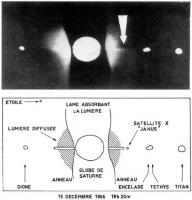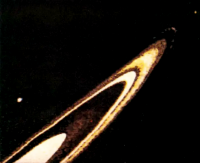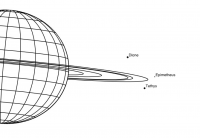Printable Version of Topic
Click here to view this topic in its original format
Unmanned Spaceflight.com _ Saturn _ Pioneer 11's 'near miss' at Saturn
Posted by: As old as Voyager Mar 16 2007, 02:56 PM
A couple of websites state that Pioneer 11 discovered a new moon of Saturn during its 1979 flyby and nearly collided with it.
http://www.uwgb.edu/DutchS/CosmosNotes/voyagr00.htm
The website says Pioneer 11 missed the previously unknown moon by only a few hundred km.
http://www.uwgb.edu/dutchs/planets/satslid.htm
Apparently the spacecraft inferred the moon's existance by the disturbances it created in Saturn's magnetic field.
Is this right? Did Pioneer 11 nearly end its mission in an unforseen Deep Impact style crash?
Posted by: As old as Voyager Mar 16 2007, 03:28 PM
Here's some more information on the near miss:
http://www.geocities.com/CapeCanaveral/Launchpad/2099/9711.html
Its a shame Pioneer 11's 'camera' wasn't looking at the object. It may have provided one of the better satellite images if it could have been imaged without smearing.
A 200km moon. Anyone know which one it was?
Posted by: Ian R Mar 16 2007, 03:33 PM
It was either Janus or Epimetheus, with the safe bet being the latter.
Posted by: belleraphon1 Mar 16 2007, 03:38 PM
Yes,
being older than Pioneer, I remember this and the Pioneer team even gave it an informal name....
quote from http://www.geocities.com/CapeCanaveral/Launchpad/2099/9711.html
"Without warning, the outputs of several of Pioneer's radiation detectors suddenly plunged to nearly zero, held roughly steady for eight seconds, and then snapped back up to their former values. For the same eight seconds, the magnetometer recorded major disturbances in Saturn's magnetic field. Pioneer had streaked through the magnetic "wake" of a moon roughly 200 km across, at a distance of no more than a few thousand kilometers -- the closest it had come to any large object since leaving Earth. Later, the villain was tentatively identified as a moon discovered the previous day from Pioneer's imaging, and suspected from earlier observations by Earth-based telescopes. After the Voyager flybys, it became clear that there are two similarly-sized moons (now named Epimetheus and Janus) in the same orbit, and there is still some uncertainty about just which one was the object of Pioneer's near-miss. "
Will have to look up more references that do not exist online (books).
Craig
Posted by: dvandorn Mar 17 2007, 01:02 AM
being older than Pioneer, I remember this and the Pioneer team even gave it an informal name....
quote from http://www.geocities.com/CapeCanaveral/Launchpad/2099/9711.html
The article doesn't give the informal name. Do you recall it? (I seem to recall the whole episode, but can't for the life of me remember the informal name.)
Good article, though -- especially as it's written by an old Usenet friend, Henry Spencer. As a proud virtual owner of several "I Corrected Henry" T-shirts from back in my Usenet days, I fondly recall his near-total and rarely-failing memory. (It's not true that I cribbed my writing style from Henry, though. When I encountered him on Usenet, I discovered that he and I have virtually identical writing styles -- another thing I enjoyed about him.)
-the other Doug
Posted by: GregM Mar 17 2007, 02:56 AM
.
Posted by: Elias Mar 17 2007, 10:55 AM
A rather detailed summary Pioneer 11 & Voyager observation of radiation absorption by rings & satellites can be found here:
http://ntrs.nasa.gov/archive/nasa/casi.ntrs.nasa.gov/19910004777_1991004777.pdf
http://ntrs.nasa.gov/archive/nasa/casi.ntrs.nasa.gov/19900017468_1990017468.pdf
The absorption effect of Janus that led to its discovery is also shown in some figures of these reports.
Also note that Cassini could have almost been destroyed when it nearly passed through the G-ring arc + Pioneer 11 passed through the core of the G-ring, but luckily the arc was not there...
Posted by: PhilCo126 Mar 17 2007, 03:00 PM
Very interesting topic... thanks for sharing! ![]()
Posted by: belleraphon1 Mar 17 2007, 07:58 PM
Yes Greg.... my synapses are probably even fuzzier but that was the name I am sure.
There was no possibility of getting good imaging of this moon during this event. First, it was unexpected and second the Pioneers used spin-scan for its camera..... there was a certain bit of rivalry between the science teams of Pioneer and Voyager, due to the simpler design of Pioneer and the heavy emphasis on particle and fields data from the Pioneers.
Pioneers were simpler spacecraft, but did a magnificent job by being first to directly probe the asteroid belt (no no knew back then whether the dust in the belts would be so dense as to damage spacecraft), first to direclty sense the radiation belts of Jupiter and Saturn, as well as determing whether the ring flyby at Saturn was safe for Voyagers (if one of these craft was go on to Uranus and Neptune). At one point in the Saturn flyby planning, one group was lobbying to send Pioneer 11 right thru the Cassini Division.
Fun thread.... brings back memories... once I get home I will check a recent book published about Pioneer...cannot remember the title right now, but I think participants of this thread will enjoy it.
PIONEER ROCK... I like that name.....
Craig
Posted by: belleraphon1 Mar 17 2007, 10:33 PM
All....
my apologies.... some on the Pioneer team had planned a trajectory through the Guerin Division, not the Cassini division....
The moon that was detected and barely missed was dubbed the Pioneer Rock.... see
"
Based on these readings and others that showed changes in the surrounding magnetic field, scientists concluded that the spacecraft had passed within about 2,500 km (1,560 miles) of what appears to be a previously undiscovered moon* with a diameter as large as 600 km (370 miles). "The object was very close," says Physicist John Simpson of the University of Chicago. "It could be rocky or composed largely of ice. Either material will effectively block high energy particles." The moonlet, in orbit about 90,000 km (56,000 miles) above Saturn's cloud tops, was nicknamed "Pioneer rock" by the scientists, and it is being officially designated as 1979 S-l (for the first new moon of Saturn discovered this year). "
from http://www.time.com/time/magazine/article/0,9171,920677,00.html
A good book on these missions is
"Pioneer Odyssey (NASA SP-396) by William Swindell and Eric Burgess Richard O. Fimmel"
And the book I referred to in my earlier post is "The Depths of Space" by Mark Wolverton.
This book is actually a chronicle of the entire Pioneer program run from Ames.
Craig
Posted by: As old as Voyager Mar 18 2007, 02:40 PM
Thanks for the info beleraphon1, I'll also be sure to check that book out.
It's interesting to note that Pioneer 10 also had a similar encounter with a previously unknown object:
http://news.bbc.co.uk/1/hi/sci/tech/460095.stm
This KBO near miss has been discussed here on UMSF before but I cannot find a link to it at the moment.
Posted by: scalbers Mar 18 2007, 06:05 PM
I think however that Janus was originally discovered from Earth based photography (still with some uncertainty) back in 1966, so the possibility of such an "encounter" with Pioneer 11 might have been anticipated?
Posted by: PhilHorzempa Jun 1 2007, 02:43 PM
Phil.
Great work Phil! However, can you, or another UMSF member,
answer a niggling question of mine?
Is Janus the "Pioneer Rock" with which Pioneer 11 almost collided, or was it one
of the other small icy moons?
Another Phil
Posted by: Ian R Jun 1 2007, 03:03 PM
Pioneer Rock was also imaged by Pioneer 11, orbiting in the region where Janus and Epimetheus are today.
I'm 99% certain that Epimetheus is the moon in question, although I'd be interested to know what Phil has to say about it.
Ian.
Posted by: Phil Stooke Jun 1 2007, 05:02 PM
A bit of detective work. Sky and Telescope (Nov. 1980, p. 360) says Pioneer 11 imaged and nearly collided with 1980S3. The IAU at this URL:
http://www.johnstonsarchive.net/astro/moonlist.html
says 1980S3 is Epimetheus.
Phil
Posted by: Ian R Jun 1 2007, 11:17 PM
According to the American Geophysical Union's publication entitled Pioneer Saturn, here are the details regarding the object(s) discovered orbiting Saturn by Pioneer 11:
1979 S1 - imaged by the photopolarimeter.
1979 S2 - discovered by the charged-particle experiment.
These were later determined to be the same object, also later observed from Earth and called 1980 S3. This was later named Epimetheus.
________________
1979 S4 - This is a different object, co-orbital to S1/S2, also later seen from Earth and called 1980 S1. This went on to be offically labelled Janus.
________________
Some of the information on the page that Phil linked to seems to contradict what I've stated above. However, since the paper in the Pioneer Saturn journal was written by Brian Marsden, I'm pretty confident of its accuracy.
Ian.
Posted by: scalbers Jun 2 2007, 04:26 PM
The details might be elsewhere in this forum & the internet, but I believe that Janus was also photographed from Earth in 1966 during an edgewise ring presentation. Did it simply take until 1980 to confirm its orbit? I recall the name Janus being used from the 1966 timeframe.
Posted by: nprev Jun 2 2007, 05:00 PM
True. The famous French astronomer http://en.wikipedia.org/wiki/Audouin_Dollfus observed a moon during 1966 when the rings were edge-on which he named Janus. It's thought that this was in fact the Janus (he might have also seen Epimetheus), but confirmation had to wait until Voyager 1.
Posted by: Ian R Jun 2 2007, 06:48 PM
Yes, this is the discovery image from 1966:
http://66.249.91.104/translate_c?hl=en&u=http://membres.lycos.fr/astrojan/decjanus.htm
Posted by: Phil Stooke Jun 2 2007, 07:44 PM
The problem with 'Janus' as seen in 1966 was that the various observations of this tiny object at the edge of the rings could not be fitted to a good orbit. Now we know that this was caused by having observations of two objects in essentially the same orbit, but that unexpected and unprecedented situation was not considered. As a reliable orbit could not be defined the situation remained unclear until the spacecraft data began to come in. The near-ring area could not be seen after ring-plane crossing because of glare, so there were no observations between 1966 and 1979. In retrospect, Dollfus observed both Janus and Epimetheus.
Phil
Posted by: Ian R Nov 5 2020, 06:51 AM
Using Mark Showalter's superlative https://pds-rings.seti.org/tools/viewer2_sat.html, we can now see that Dollfus did indeed discover Janus with the image I posted earlier:
Posted by: Ian R Nov 5 2020, 07:26 AM
We can also confirm that Pioneer 11 was the first spaceprobe to image Epimetheus, with photo F-12E taken 00:29 hrs, 1979-SEP-01. The F-ring and Tethys are also visible:
The Saturn Viewer produces a plot of the same situation albeit as seen from Earth; here, the view is from beneath the ring plane (Pioneer was above it). Adding to the confusion is Dione, which is somewhat in the foreground and out of Pioneer's field-of-view in the image above. But the issue is seemingly settled: 1979 S1 was indeed Epimetheus:
Powered by Invision Power Board (http://www.invisionboard.com)
© Invision Power Services (http://www.invisionpower.com)




